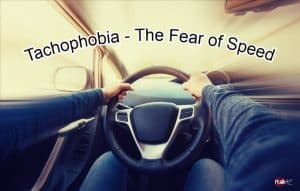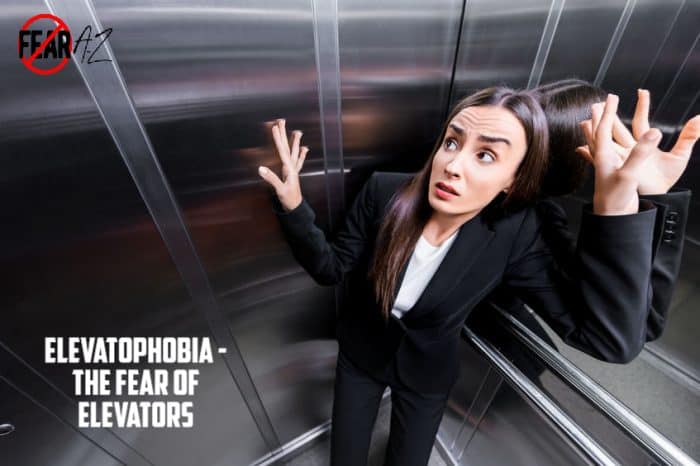Share This Article
Putting a Limit on the Fear of Speed
Being nervous in a vehicle traveling at high speed is normal, but does your fear go beyond that?
Do you find it nearly impossible to be inside a fast-moving vehicle?
Are you paralyzed by the thought of going on a roller coaster or any other fast moving thrill ride at a theme park? Does the thought of a bicycle going downhill and picking up speed terrify you?
Does the mere thought of race cars zipping around a track lead to a panic attack?
If your answer to these questions is yes, or even maybe, you are may be suffering from tachophobia, the excessive fear of speed.
It can be difficult to deal with the terror of getting inside a car, train, or plane. Maybe the simple rumbling of vehicles passing by your house can make you feel anxious.
For those with a serious case of tachophobia even a brisk walk can make your heart pound more than any basic exercise should. This is an extreme example, but may be real for someone with tachophobia.
The irrational fear of moving fast or even seeing objects moving quickly can severely limit your lifestyle. It’s time to put in the self-reflection and the work needed to gradually overcome your fear.

What Is Tachophobia?
Tachophobia originates from the Greek words tachos, meaning “speed,” and phobos, meaning “deep dread.” It is an irrational and extreme fear of speed. Tachophobia is a specific fear and is included under the umbrella of anxiety disorders in the DSM-V.
While extreme speed is scary for many people, tachophobics fear even walking or running fast. It can result in symptoms of anxiety such as a panic attack.
Sometimes even the mere thought of moving quickly may lead to strong feelings of anxiety and dread. You may find it almost impossible to be in a fast-moving car, a boat, a plane, or any form of transportation that moves faster than walking. You may also be triggered by seeing fast-moving objects.
Tachophobia makes day-to-day life difficult. You may have to live within walking distance of your home to avoid getting inside a moving vehicle. If there are no nearby restaurants or grocery stores, all of your necessities may need to be delivered.
Creating and maintaining relationships may also be difficult if you can’t go anywhere that isn’t within walking distance.
What Causes the Fear of Speed?
Tachophobia may result from a lack of sense of control where fast-moving objects seem chaotic or erratic. But this isn’t the only reason why people develop this phobia.
As yet, there are no confirmed causes of tachophobia. But here are some factors that may contribute to it:
Genetics
Some psychology experts say this phobia may be attributed to a person’s genetic makeup and childhood environment. Both factors play important roles in the development of the disorder.
People with a history of mental illness in their family may have a greater chance of developing tachophobia because of the genetic predisposition for anxiety and obsessive disorders.
Trauma
Apart from family history, a traumatic event may have occurred leading to the development of tachophobia.
Were you traumatized after losing a parent or loved one in a fatal car crash caused by speeding? Were you yourself in some type of crash, and now you can’t get back in a moving vehicle? These occurrences are more than enough to sow the seeds of irrational fear.
Unfortunately, there isn’t a lot of research on such phobias as tachophobia. Determining how or why it develops can be difficult.
What Are Common Tachophobia Symptoms?
Like other phobias, those with tachophobia tend to experience anxiety when they encounter their fear or even think of it.
Phobias appear in different ways, but here are some common symptoms:
Mental/Emotional Symptoms
- Avoiding places where they might see anything fast-moving (traffic, car racing, amusement parks)
- Deteriorating relationships because of the inability to travel
- Experiencing anxiety while merely thinking about moving quickly
- Intrusive thoughts
- Panic while watching movie or TV scenes that involve fast vehicles
- Refusing to get into a car, bus, train, plane, or any other moving vehicle
- Refusing to go anywhere that isn’t within walking distance
Physical Symptoms
- Chest pain
- Difficulty breathing
- Increased heart rate
- Muscle tension
- Nausea
- Numbness
- Shaking
- Sweating
Potential Tachophobia Treatments
While people with tachophobia may feel some brief relief when they avoid fast-moving objects, their condition may worsen in the long run if they continue believing that speed is something to be feared and avoided.
The treatment of any illness or disease begins by discovering the root cause if possible. After that, there are a number of self-help and professional treatment options available to help you overcome your fear of speed.
Self-Help Options
Meditation and Mindfulness
When you feel the fear of speed creeping in, consciously apply simple relaxation techniques like meditation and deep breathing. Practice mindfulness by investigating the root cause of your fear and reversing your negative associations with it.
Physical Activity
Simple exercise can reduce stress and anxiety. You can boost your endorphin levels and focus on something else in the meantime. Cardio and strength training can help you feel more centered and able to deal with your fears.

Professional Help for Tachophobia
Exposure Therapy
Exposure therapy involves being exposed to the source of fear to make the triggering factor ineffective over time. Work with an experienced therapist to ensure that this is the proper treatment for you and that you will not be exposed to too much too soon.
The ultimate goal is for you to cope with the exposure to speed until it leads to little to no irrational anxiety.
Dialectical Behavior Therapy (DBT)
DBT is a type of cognitive behavioral therapy meant for people struggling with emotion regulation. It centers on mindfulness and acceptance of experiences.
The treatment begins with understanding and acknowledging your irrational fear without judging your emotional response to certain situations. You will learn to observe your emotions and identify your triggers, which will help you develop mechanisms to alter the feelings that are not helpful.
With DBT, you can learn to act opposite to what your irrational fear urges you to do. Your emotion regulation skills will help you change your reaction to your triggers.
Medication
In extreme cases of tachophobia, patients may be administered anti-anxiety medication after consultation with a medical professional.
Medication can help reduce the intensity of physical symptoms. However, taking medication alone is not a treatment for phobia.
Coping with Tachophobia
If you are diagnosed with a phobia, seek treatment. Overcoming phobias can be difficult, but it’s not impossible.
Don’t be afraid or embarrassed about seeking help. The right treatment can help you learn to manage your fears and lead a productive and fulfilling life.
The Anxiety and Depression Association of America (ADAA) is a great resource for those seeking help. They offer helpful resources for locating a therapist, along with a range of talks on how to overcome specific phobias.
Final Thoughts
Phobias are a source of genuine distress for many individuals. Luckily, treatment is available. You just have to be willing to get to the root of your fears and seek the help you need.



